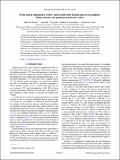Fermi energy dependence of first- and second-order Raman spectra in graphene: Kohn anomaly and quantum interference effect
Author(s)
Hasdeo, Eddwi H.; Nugraha, Ahmad R. T.; Dresselhaus, Mildred; Saito, Riichiro
DownloadPhysRevB.94.075104.pdf (1.589Mb)
PUBLISHER_POLICY
Publisher Policy
Article is made available in accordance with the publisher's policy and may be subject to US copyright law. Please refer to the publisher's site for terms of use.
Terms of use
Metadata
Show full item recordAbstract
Intensities of the first- and the second-order Raman spectra are calculated as a function of the Fermi energy. We show that the Kohn anomaly effect, i.e., phonon frequency renormalization, in the first-order Raman spectra originates from the phonon renormalization by the interband electron-hole excitation, whereas in the second-order Raman spectra, a competition between the interband and intraband electron-hole excitations takes place. By this calculation, we confirm the presence of different dispersive behaviors of the Raman peak frequency as a function of the Fermi energy for the first- and the second-order Raman spectra, as observed in some previous experiments. Moreover, the calculated results of the Raman intensity sensitively depend on the Fermi energy for both the first- and the second-order Raman spectra, indicating the presence of the quantum interference effect. The electron-phonon matrix element plays an important role in the intensity increase (decrease) of the combination (overtone) phonon modes as a function of the Fermi energy.
Date issued
2016-08Department
Massachusetts Institute of Technology. Department of Electrical Engineering and Computer Science; Massachusetts Institute of Technology. Department of PhysicsJournal
Physical Review B
Publisher
American Physical Society
Citation
Hasdeo, Eddwi H., Ahmad R. T. Nugraha, Mildred S. Dresselhaus, and Riichiro Saito. "Fermi energy dependence of first- and second-order Raman spectra in graphene: Kohn anomaly and quantum interference effect." Phys. Rev. B 94, 075104 (2016). ©2016 American Physical Society.
Version: Final published version
ISSN
2469-9950
2469-9969